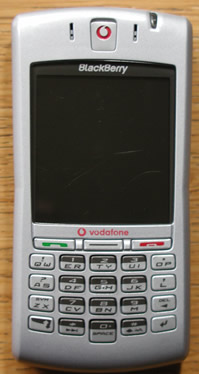 Following on from my recent detailed review of the Vodafone 7100v Blackberry, I thought it would be worth passing on a few tips I’d learnt over the process. One attempting to reassure readers through the scary process of upgrading the operating system on the 7100 Blackberry; the other, a solution for syncing your information with an Apple Mac – not something that is natively supported by RIM or Vodafone.
Following on from my recent detailed review of the Vodafone 7100v Blackberry, I thought it would be worth passing on a few tips I’d learnt over the process. One attempting to reassure readers through the scary process of upgrading the operating system on the 7100 Blackberry; the other, a solution for syncing your information with an Apple Mac – not something that is natively supported by RIM or Vodafone.
Upgrading the software on a Vodafone 7100v Blackberry
Before properly using the Blackberry, I paid a visit to the Blackberry Web site and downloaded the latest software update for my handheld. This is one of the things with advanced devices such as this: they get to be so much like computers that they have new software upgrades available on a regular basis.
Upgrading the software on the handset was quite a daunting experience, because my 7100v refused to connect correctly. I would get repeated error messages, saying it wasn’t connected properly, and the only way to get it connected was to unplug and then reconnect the cable from the handset.
Updating the software on the Blackberry essentially wipes everything off the device before putting new software on, there were a few occasions when I thought, “oh dash, I’ve broken it” because nothing seemed to be responding. These worries proved to be unfounded, as after a few minutes I was greeted by the Vodafone logo appearing on-screen signaling success of the upgrade process.
Syncing (with a Mac)
 After updating the software, which by the way you need a Windows computer for, I set about syncing the Blackberry with my Mac. My existing phone, the Sony Ericsson P910i, works correctly out of the box with Mac OS X’s iSync application, syncing wirelessly over Bluetooth within a few seconds.
After updating the software, which by the way you need a Windows computer for, I set about syncing the Blackberry with my Mac. My existing phone, the Sony Ericsson P910i, works correctly out of the box with Mac OS X’s iSync application, syncing wirelessly over Bluetooth within a few seconds.
The 7100v, although it has Bluetooth, doesn’t have a Bluetooth synchronization profile, which in my mind is something the Blackberry developers should have thought about, as it would have been a relatively easy software fix. As a result of this, the Blackberry wouldn’t sync with iSync and the cable wouldn’t work either, as iSync had no drivers for it.
A little research on the Internet revealed a company by the name of PocketMac who make Mac/Blackberry sync software. Upon request, they kindly sent me a free license key for their software, which then allowed me to seamlessly sync my address book and calendar from my Mac to my Blackberry.
PocketMac Blackberry in operation
I did have one or two issues with it initially, but these were to do with using Apple’s new released operating system update, Tiger, which has a new version of iCal, a calendar application, which initially refused to work with PocketMac.
Some lateral thinking was needed – by getting iCal to sync to Entourage, the Mac equivalent of Outlook on Windows, and then telling PocketMac to sync calendars from Entourage, I got it working.
Despite the Tiger problem, that they tell me will be fixed soon, I was impressed with PocketMac Blackberry. It fills a large gap left by RIM’s lack of Mac support.
 The insatiable appetite of hungry surfers desperate for more information, analysis and intelligence has fuelled a database market growth of 10.3 percent in 2004, according to research released by the Gartner Group.
The insatiable appetite of hungry surfers desperate for more information, analysis and intelligence has fuelled a database market growth of 10.3 percent in 2004, according to research released by the Gartner Group. Despite being a still a relatively small part of the overall RDBMS market, the Linux segment is as hot as an extra spicy vindaloo, registering 118 percent growth in 2004, more than doubling from US$300 million in 2003 to over US$650 million in 2004.
Despite being a still a relatively small part of the overall RDBMS market, the Linux segment is as hot as an extra spicy vindaloo, registering 118 percent growth in 2004, more than doubling from US$300 million in 2003 to over US$650 million in 2004.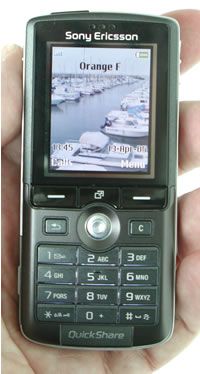 About a month ago I had the chance to spend two days with a pre-release version of the Sony K750i handset and as it’s now closer to the release of the handset, I thought an overview of the product might be timely.
About a month ago I had the chance to spend two days with a pre-release version of the Sony K750i handset and as it’s now closer to the release of the handset, I thought an overview of the product might be timely. You morph it in to a camera by sliding the lens cover at the back of the device. Using the 2mpx camera you can easily captures clear pictures with vivid colours during light days.
You morph it in to a camera by sliding the lens cover at the back of the device. Using the 2mpx camera you can easily captures clear pictures with vivid colours during light days.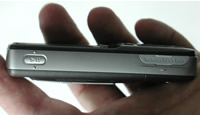 Video recording is OK, given the devices restrictions.
Video recording is OK, given the devices restrictions.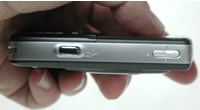 I’d just assumed the K750i would have a ‘normal’ headphone jack, letting me choose the headphones that excited me, but the provided headphones had to be connected via a Sony-interface at the bottom of the phone. This brings obvious advantages, like them having a mic, letting to let you use them as a hands-free set.
I’d just assumed the K750i would have a ‘normal’ headphone jack, letting me choose the headphones that excited me, but the provided headphones had to be connected via a Sony-interface at the bottom of the phone. This brings obvious advantages, like them having a mic, letting to let you use them as a hands-free set. Vodafone execs spent the morning cackling wildly to themselves, throwing wads of dollar bills in the air and rolling around silk-covered beds covered in cash as record revenues and profits for its full year results were announced to the world.
Vodafone execs spent the morning cackling wildly to themselves, throwing wads of dollar bills in the air and rolling around silk-covered beds covered in cash as record revenues and profits for its full year results were announced to the world. But in-between triumphant licks of triple-thick Cornish clotted cream, Sarin sounded a cautious note, warning that competition was rising.
But in-between triumphant licks of triple-thick Cornish clotted cream, Sarin sounded a cautious note, warning that competition was rising.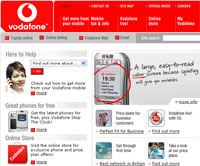 Vodafone performed particularly well in strong markets such as the US and Spain, with revenues growing at more than 20% year on year.
Vodafone performed particularly well in strong markets such as the US and Spain, with revenues growing at more than 20% year on year.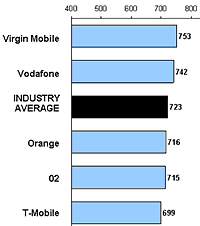 Orange has triumphed in a study rating customer satisfaction among mobile phone contract providers, with Virgin Mobile coming in top in the pre-pay sector, according to the 2005 UK Mobile Telephone Customer Satisfaction Study, run by J.D. Power and Associates.
Orange has triumphed in a study rating customer satisfaction among mobile phone contract providers, with Virgin Mobile coming in top in the pre-pay sector, according to the 2005 UK Mobile Telephone Customer Satisfaction Study, run by J.D. Power and Associates. The authors of the study claim that the results reflect the positive impact of increasing competition and lower tariffs.
The authors of the study claim that the results reflect the positive impact of increasing competition and lower tariffs. The contract segment seemed a well-chuffed bunch too, with satisfaction levels rising to 733 index points from 720 index points in 2004.
The contract segment seemed a well-chuffed bunch too, with satisfaction levels rising to 733 index points from 720 index points in 2004.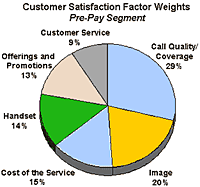 Mobile technology and photo messaging is still a hot potato, with 35 percent of all mobile owners snapping on camera phones and 21 percent sending photos from their mobiles.
Mobile technology and photo messaging is still a hot potato, with 35 percent of all mobile owners snapping on camera phones and 21 percent sending photos from their mobiles. Like the spotty geek who turns up in the pub with a stunner on his arm, Bluetooth has confounded critics by reaching the significant milestone of five million Bluetooth units shipping per week.
Like the spotty geek who turns up in the pub with a stunner on his arm, Bluetooth has confounded critics by reaching the significant milestone of five million Bluetooth units shipping per week.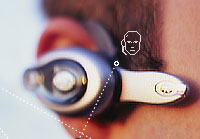 “When you couple that with the recently announced collaboration between the Bluetooth SIG and UWB,” Foley continued, “Bluetooth technology will further reinforce its leading position far into the future. Even today, we expect this will have a positive impact in Bluetooth uptake.”
“When you couple that with the recently announced collaboration between the Bluetooth SIG and UWB,” Foley continued, “Bluetooth technology will further reinforce its leading position far into the future. Even today, we expect this will have a positive impact in Bluetooth uptake.” Seizing a convenient opportunity to squeeze in a bit of PR, Rosenberg added, “Already today, Nokia has introduced state-of-the-art mobile devices that allow data transmission using both high- speed cellular networks, WLAN hot spot access, and Bluetooth technology.”
Seizing a convenient opportunity to squeeze in a bit of PR, Rosenberg added, “Already today, Nokia has introduced state-of-the-art mobile devices that allow data transmission using both high- speed cellular networks, WLAN hot spot access, and Bluetooth technology.” Nokia has surprised pundits at the LinuxWorld Summit in New York by announcing their new Nokia 770 Internet Tablet, a handheld Wi-Fi device for accessing the Internet around the home over a wireless broadband connection.
Nokia has surprised pundits at the LinuxWorld Summit in New York by announcing their new Nokia 770 Internet Tablet, a handheld Wi-Fi device for accessing the Internet around the home over a wireless broadband connection.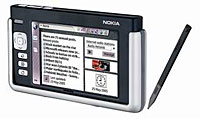 The included 1500mAh battery should keep going for about 3 hours of browsing or 7 days of standby time.
The included 1500mAh battery should keep going for about 3 hours of browsing or 7 days of standby time.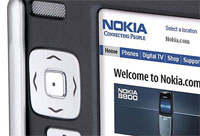 Unlike some teensy-weensy mobile displays, Nokia’s sizeable 800×480 pixel screen should make browsing the web and interacting with email a reasonably practical proposition.
Unlike some teensy-weensy mobile displays, Nokia’s sizeable 800×480 pixel screen should make browsing the web and interacting with email a reasonably practical proposition.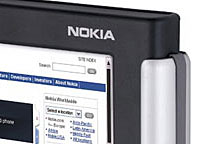 Naturally, there’s an orgy of acronyms detailing the zillion and one audio and video formats that the unit supports (deep breath): MP3, Real Audio, MPEG4, AAC, WAV, AMP, MP2 audio support, with MPEG1, MPEG4, Real Video, H263, AVI, 3GP video support and a slew of common graphics formats supported, including Animated GIF JPEG, BMP, GIF, TIFF, PNG and SVG-Tiny. Phew!
Naturally, there’s an orgy of acronyms detailing the zillion and one audio and video formats that the unit supports (deep breath): MP3, Real Audio, MPEG4, AAC, WAV, AMP, MP2 audio support, with MPEG1, MPEG4, Real Video, H263, AVI, 3GP video support and a slew of common graphics formats supported, including Animated GIF JPEG, BMP, GIF, TIFF, PNG and SVG-Tiny. Phew!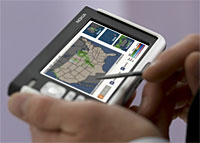 “Linux is a logical choice for the Nokia 770 Internet Tablet as Linux and the Open Source development platform provide us with fast and efficient solutions to build products for this new Nokia product category,” added Janne Jormalainen.
“Linux is a logical choice for the Nokia 770 Internet Tablet as Linux and the Open Source development platform provide us with fast and efficient solutions to build products for this new Nokia product category,” added Janne Jormalainen. Despite prices being pushed downwards by fierce price competition, worldwide wireless LAN equipment revenue rose 20% to US$767.6 million (~£420m ~€610m) between the fourth quarter of 2004 and the first quarter of 2005.
Despite prices being pushed downwards by fierce price competition, worldwide wireless LAN equipment revenue rose 20% to US$767.6 million (~£420m ~€610m) between the fourth quarter of 2004 and the first quarter of 2005.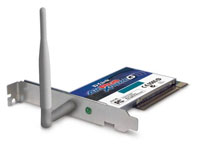 That’s a thumping great 37% increase in unit shipments, representing not-to-be-scoffed-at sales of 6 million.
That’s a thumping great 37% increase in unit shipments, representing not-to-be-scoffed-at sales of 6 million. D-Link barged ahead of Cisco-Linksys to grab second place, with NETGEAR in fourth position.
D-Link barged ahead of Cisco-Linksys to grab second place, with NETGEAR in fourth position.